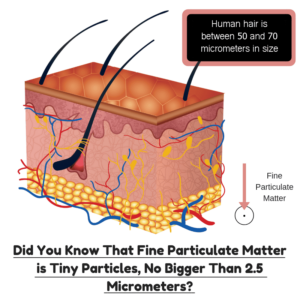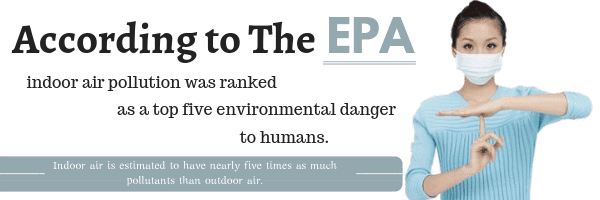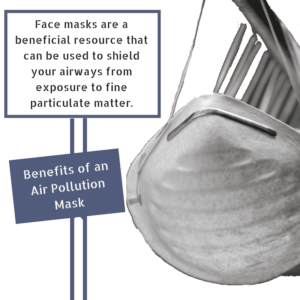Does Wearing a Face Mask Protect from Air Pollution?
 Did you know that fine particulate matter is tiny particles, no bigger than 2.5 micrometers? This matter is so small that it is often compared to human hair to show the significance in size, as human hair is between 50 and 70 micrometers in size. Therefore, the risks of ingesting or inhaling these very small airborne pollution matters is a major threat to public health – especially in indoor environments.
Did you know that fine particulate matter is tiny particles, no bigger than 2.5 micrometers? This matter is so small that it is often compared to human hair to show the significance in size, as human hair is between 50 and 70 micrometers in size. Therefore, the risks of ingesting or inhaling these very small airborne pollution matters is a major threat to public health – especially in indoor environments.
According to testing conducted by World Health Organization, it was found that 9 out of 10 people around the world are breathing polluted air. Pollution indoors can be caused by cleaning agents, cooking fumes, new furniture and flooring, building materials, and other external factors emitted into the air by humans. This can lead to large quantities of fine particulate matter inside the confined environment, and conversely can lead to several persisting health issues.
What is Indoor Air Pollution
Air pollution is usually associated with being outdoors, however, the air inside indoor environments like in your house or office could also be polluted – sometimes worse than outdoor air! According to the EPA (Environmental Protection Agency) indoor air pollution was ranked as a top five environmental danger to humans. Indoor air is estimated to have nearly five times as much pollutants than outdoor air, and some homes may even have a hundred times more pollutants than that of outdoor air, scary right?
Indoor air quality is drastically impacted as a result of pollution inside indoor spaces. IAQ (Indoor Air Quality) is the air quality within and around buildings and structures that are known to affect the health, comfort, and well-being of exposed individuals.
As more and more research and information are obtained regarding the significant threat present from high levels of indoor air pollution, a growing concern has taken place as the need for a mitigation solution of these pollutants is being called upon.

Causes of Indoor Air Pollution
It was estimated that the average American spends close to 90% of their time indoors, a significant amount of time that can have a significant impact on human health. Indoor air pollution can be caused by a variety of things inside your indoor environment – some things producing more pollutants than others. There are many sources of indoor air pollution including combustion (tobacco smoke, stoves, fireplaces, and wood stoves), household products, building materials, biological agents (microbes, pets), and mold.
- Combustion Pollutants: These types of pollutants are gases or particles that come from burning materials. Inside homes, the large contributing sources of combustion pollution are from improperly vented burning appliances such as space heaters, woodstoves, gas stoves, water heaters, dryers, & fireplaces.
- Volatile Organic Compounds (VOCs): Volatile Organic Compounds are chemicals that are widely used as ingredients in household products, paints, varnishes, and wax that are emitted as gases from certain solids or liquids. Sources of VOCs inside your home could include paints, wood preservatives, aerosol spray, cleaners and disinfectants, moth repellents, air fresheners, stored fuels, automotive products, hobby supplies, and pesticides. VOC concentrations are consistently higher indoors – up to ten times higher – than outdoors. These pollutants can present both short-term and long-term adverse health effects.
- Pollutants That Trigger Asthma: Asthma triggers are pollutants commonly found inside indoor environments (schools, homes, and offices). The pollutants identified as asthma triggers include mold, dust mites, secondhand smoke, and pet dander. Symptoms such as coughing, chest tightness, wheezing, and breathing problems are all associated with asthma.
- Mold: An extremely common pollutant found inside indoor environments is the microorganism mold. Molds are living things that produce spores- they float in the air and grow on surfaces. If you inhale or touch mold it can cause fever-type symptoms such as sneezing, runny nose, red eyes, and skin rash.
Symptoms of Indoor Air Pollution
Pollution, as you can imagine, can have an impact on the health of individuals exposed to these airborne contaminants. Symptoms from indoor air pollution can range from short-term to long-term effects depending on the length and concentration of exposure. Poor indoor air quality symptoms can easily be mistaken for symptoms of other illnesses such as allergies, stress, colds, and influenza. The most common symptoms of indoor air pollution include:
- Coughing
- Sneezing
- Watery eyes
- Fatigue
- Dizziness
- Headaches
- Upper respiratory congestion
 Benefits of an Air Pollution Mask
Benefits of an Air Pollution Mask
Air pollution inside the environment can range in size from larger to small particulate matter – the size of the matter is significant as it can contribute to potentially severe health issues. Health issues will start to become prevalent when particulate matter that are less than 2.5 microns in diameter are present in the air and become ingested or inhaled upon exposure. Face masks are a beneficial resource that can be used to shield your airways from exposure to fine particulate matter. Typically, face masks will cover both the nose and the mouth to prevent the ingestion or inhalation of toxic airborne pollutants in the air.
Types of Masks for Pollution Protection
There are many things you can do to make the air in your home better – and avoid the pollutants in the air. If you need immediate relief and protection inside your home, you can put a face mask to work. The choice of which type of face mask to use can be a difficult decision, as each type of mask can possess different benefits. The three different types of masks for pollution protection include the following:
- N95 Mask: An N95 mask respirator is a respiratory protective device that was designed to fit closely to the face to shield and filtrate airborne particles. N95 is a designation that means that the mask has undergone careful testing, and proved the respirator blocked at least 95 percent of very small, 0.3 micron, particles in the air.
- Dust Mask: Dust masks are disposable filters that can be worn to protect against non-toxic nuisance dusts- used for mowing, gardening, sweeping, and dusting. This type of mask is not NIOSH approved and are not respirators, which means it does not offer protection against hazardous dusts, gases, or vapors.
- Odor & Particulate Mask: An odor & particulate protection mask offers relieve from both dangerous particulate matter and noxious odors. These types of masks provide the best of both worlds, and protects from fine particulate matter such as mold, VOCs, and other chemicals, as well as noxious odors.
Best Pollution Mask
Chemical odors and malodors are everywhere and if you are sensitive to these pollutants, you will want to have an effective pollution mask. An effective pollution face mask will be able to chemically dismantle the vast majority of irritating fumes and chemical compounds before they ever reach your nose or mouth. The EnviroKlenz Breathing Mask for Pollution was specifically designed for people with chemical sensitivities and allergies to minimize their exposure to them, both indoors and outdoors. The EnviroKlenz Mask is a reusable, lightweight, and comfortable mask that contains a mini air filtration device that covers the nose and mouth. The technology utilized in the mask is the patented EnviroKlenz technology that is designed to neutralize airborne odors and the fibers of the mask can filter out many common particulates.

Comments
Post a Comment